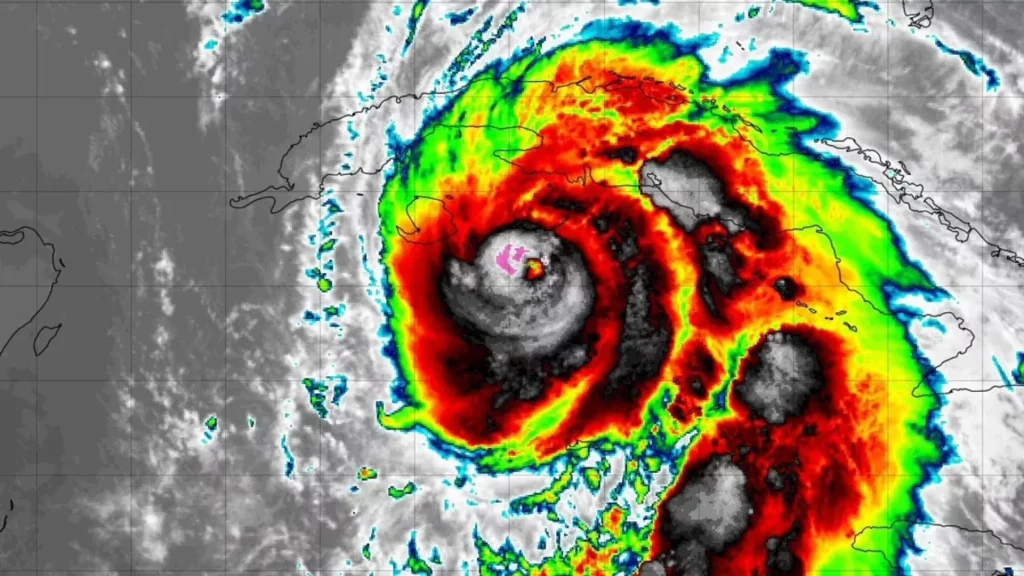A rare November hurricane is heading toward the United States and might reach as early as this weekend.
Storm Rafael has been upgraded to a Category 2 hurricane, with potential impact in Texas, Florida, and the Panhandle.
The hurricane is predicted to impact Western Cuba and the Isle of Youth within the next 12 hours.
Experts estimate that Rafael will emerge as a hurricane in the southeastern Gulf of Mexico tonight.
Residents in the Florida Keys could expect tropical storm conditions, according to the National Hurricane Center (NHC).
Americans have been advised to secure unsecured outdoor things in preparation for severe winds and flooding.
According to AccuWeather Senior Meteorologist Bill Deger, slight changes in Rafael’s strength and surrounding winds can have a significant impact on where it heads next.
If the storm intensifies or winds change direction, its route may shift.
Rafael has four distinct pathways to the US, but is most likely to land in Louisiana, according to a spaghetti model (named after the threads of pasta).
The National Hurricane Center has issued a tropical storm warning for the Lower and Middle Florida Keys because to Rafael’s potential for up to three inches of rainfall and increased tornado risk.
‘Bands of rain with gusty winds may affect this area until Wednesday night. The Weather Channel said that tornadoes are possible in the Keys and far southwestern Florida.
The National Hurricane Center (NHC) warns that the impact of Rafael on the Gulf Coast of the United States is uncertain, but citizens should stay tuned for updates.
Rafael was about 130 miles south-southeast of Havana at 10:00 a.m. ET, traveling northwest at 14 mph with maximum sustained winds of 110 mph, according to the National Hurricane Center.
A hurricane warning is in effect for this area, and residents should prepare for ‘severe hurricane-force winds, life-threatening storm surge, and destructive waves,’ according to the alert.
According to the National Hurricane Center, the storm will also bring heavy rain to sections of the Western Caribbean through early Thursday, including Jamaica, the Cayman Islands, and western Cuba.
According to the National Hurricane Center, Rafael is likely to diminish as it advances toward the Gulf of Mexico.
‘It is also possible that Rafael is ripped apart by powerful winds high in the atmosphere and dissipates in the Gulf of Mexico before hitting landfall,’ Deger explained.
An alternate course prediction has Rafael going westward across the Gulf rather than north toward the United States. If that happens, the impact on the United States will be limited, according to AccuWeather.

If Rafael weakens but remains intact and moves toward the northern Gulf Coast, it may increase rainfall with a cold front this weekend and early next week, according to The Weather Channel.
Rafael is the seventeenth named storm of the 2024 Atlantic hurricane season.
Although not predicted to directly affect Florida, tropical storm conditions may put additional burden on local towns still recovering from hurricanes Helene and Milton, which devastated the state within two weeks of each other.
These storms caused severe devastation in the Sunshine State, killing an estimated 54 people.
According to Florida’s Office of Insurance Regulation, anticipated insurance claims from Helene and Milton have approached $4 billion.
As Rafael approaches the United States, Floridians should keep an eye out for weather forecast updates, according to the National Hurricane Center.
Hurricanes seldom make landfall in the United States during November.
This is because we are nearing the end of the Atlantic hurricane season, and favorable circumstances for tropical storm formation have lessened.
Since 1851, 287 hurricanes have made landfall in the US, with only four hitting in November, according to the NOAA database.

The most recent one, Hurricane Nicole, struck Florida in November 2022. Before that, the United States had not experienced a November hurricane since Katie in 1985.
According to NOAA, Rafael is the fiercest storm to have passed across the northern Caribbean in November since 2009.
As the storm approaches Cuba, experts predict it might intensify into a Category 3 hurricane before reaching landfall.
Nine storms – including Rafael – have rapidly intensified in the Atlantic basin this year, fueled by unprecedentedly high ocean temperatures.
Rapid storm intensification is becoming more common as the atmosphere and oceans warm due to climate change, according to NOAA.


